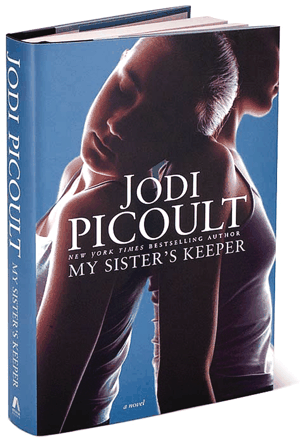The Ties That Bind
- Amy Wecker, MD and
- Lynn Wecker, PhD

My Sister’s Keeper. Jodi Picoult. Washington Square Press, New York. 2004. 423 pages. $14.00 ISBN: 0743454537
It has been said that the technological capabilities of our society may exceed our ability to deal with them on both a social and ethical level. My Sister’s Keeper leads us to explore some of these issues, placed in the context of a novel.
This is the story of a family of five: Sara and Brian, the parents, and their three children, Jesse, Kate, and Anna. Sara and Brian had planned to have only two children, Jesse and Kate, but when Kate was diagnosed with APL (acute promyelocytic leukemia, a rare myelocytic leukemia with an incidence of about twelve hundred people yearly and a prognosis of nine months to three years), they began to question their decision. Sara and Brain were told that with APL, the best shot at remission is via bone marrow transplantation; however, their son Jesse was not a match. In comes the family’s trustworthy pediatrician casually stating, “I’ve known lots of families where one sibling isn’t a match, but another sibling turns out to be just right.” This rather nonchalant message to Sara and Brian forms the basis for the entire plot.
Sara conceives three embryos via in vitro fertilization, one of which is a perfect human leukocyte antigen (HLA) match. Thus, baby Anna is born. Her cord blood was harvested and its use allowed Kate’s cancer to go into remission for a few years. Throughout her childhood, Anna is called upon continually to donate blood and then bone marrow. As the novel begins, thirteen-year-old Anna is being pressured by her mother into donating a kidney, as Kate is now on dialysis and in danger of dying within months without the transplant. Anna, feeling that no one is on her side, enlists the help of a lawyer and seeks medical emancipation from her parents. She feels very strongly that her kidney belongs to her, and no one, not even her mother, can lay claim to it.
The novel takes place during the few weeks leading up to and surrounding the trial and leads us to analyze the ethics of the potential transplant that is tearing the family apart. Few would argue the harmlessness of taking cord blood from a newborn, but what of the subsequent procedures? A bone marrow biopsy is quite painful, and donating a kidney is a major surgery with potential life-changing implications. In this case, Anna would have to give up her passion for soccer, at which she is quite talented, as she is advised to avoid contact sports so as to prevent damage to a lone remaining kidney. Also, what of the psychological damage? Anna has been told the story of how she saved her sister’s life with cord blood over and over and over. She feels as if her entire reason for being is to serve as an organ donor for Kate—and is this not true? On the other hand, Sara, the mother, does not want to let her other daughter die when a perfect tissue match is so accessible. How much pressure is within her rights? Also, it is possible that Kate could die from the APL with or without the transplant, so what constitutes acceptable risk?
Sister’s Keeper is written from the perspectives of all its characters. The viewpoint changes with each chapter, although Anna, mature beyond her years, and Sara, her overly emotional mother, seem to predominate. We also get the viewpoint of Brian, the stable (if a bit boring) father and professional firefighter; Jesse, the troubled pot-smoking pyromaniac teenage son; and finally, Kate, the ill and hopeful recipient of her younger sister’s compatible organ. Then there is Campbell, the handsome sarcastic lawyer, who has a seeing-eye dog, which is curious, given that he is not blind. He takes on the case pro bono for the potential publicity, but of course, ends up emotionally involved. And let us not forget Julia, the court-appointed guardian ad litem (a child’s advocate during legal proceedings that involve a minor) who turns out to be Campbell’s estranged, one true love.
Though we surely must face these and other issues as our technologic capabilities advance by leaps and bounds and our legislation becomes more conservative, this novel may not be the best vehicle for confronting these dilemmas. We were rather disappointed with the formulaic characters, the stiff writing, and the over-dramatization of virtually everything. The issues, however, are real and presented from a variety of different angles, and this book may be a useful teaching tool as we train a new generation of scientists and physicians to struggle with our brave new world.
- © American Society for Pharmacology and Experimental Theraputics 2006



